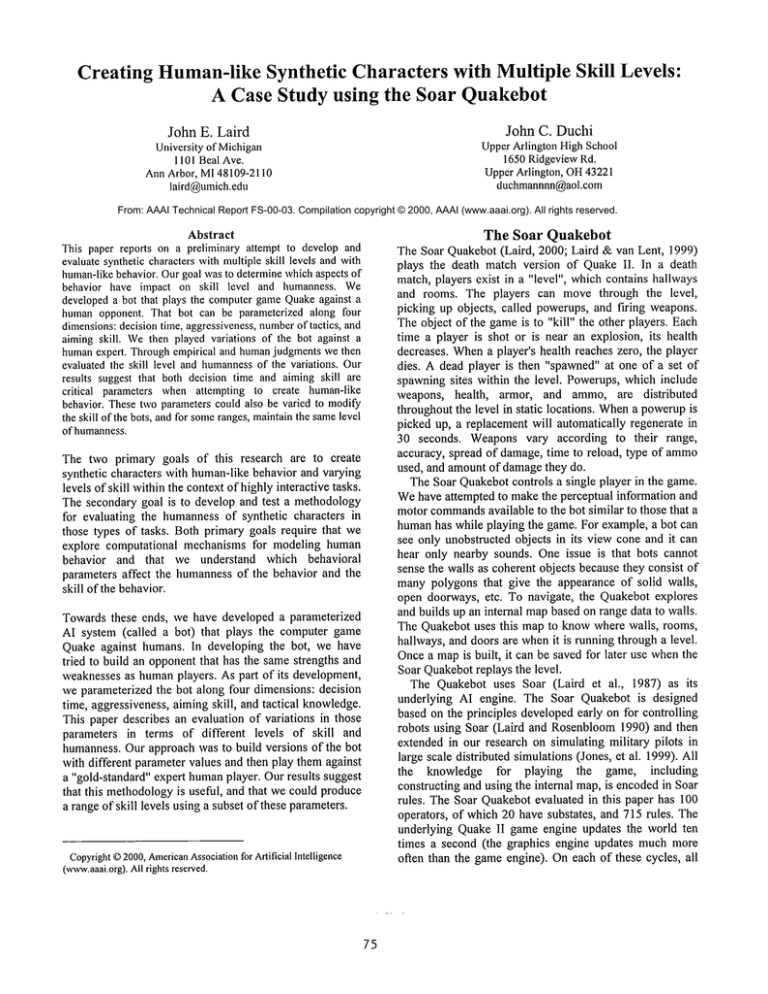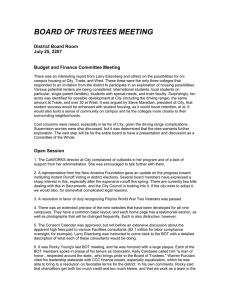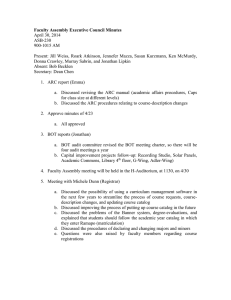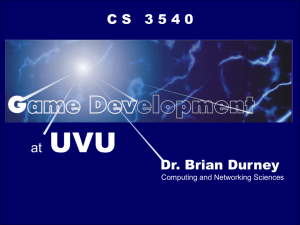
Creating Human-like Synthetic Characters with Multiple Skill Levels:
A Case Study using the Soar Quakebot
John C. Duchi
UpperArlington HighSchool
1650RidgeviewRd.
UpperArlington, OH43221
duchmannnn@aol.com
John E. Laird
Universityof Michigan
1101Beal Ave.
AnnArbor, MI48109-2110
laird@umich.edu
From: AAAI Technical Report FS-00-03. Compilation copyright © 2000, AAAI (www.aaai.org). All rights reserved.
Abstract
This paper reports on a preliminary attempt to develop and
evaluatesynthetic characterswithnmltipleskill levels andwith
human-likebehavior. Ourgoal wasto determinewhichaspects of
behavior have impact on skill level and humanness. We
developeda bot that plays the computergameQuakeagainst a
humanopponent. That bot can be parameterized along four
dimensions:decisiontime, aggressiveness,numberof tactics, and
aimingskill. Wethen played variations of the bot against a
humanexpert. Throughempirical and humanjudgmentswe then
evaluated the skill level and humanness
of the variations. Our
results suggest that both decision time and aimingskill are
critical parameters whenattempting to create human-like
behavior. Thesetwoparameterscould also be varied to modify
the skill of the bots, andfor someranges,maintainthe samelevel
of humanness.
The two primary goals of this research are to create
synthetic characters with human-like behavior and varying
levels of skill within the context of highly interactive tasks.
The secondary goal is to develop and test a methodology
for evaluating the humannessof synthetic characters in
those types of tasks. Both primary goals require that we
explore computational mechanisms for modeling human
behavior and that we understand which behavioral
parameters affect the humannessof the behavior and the
skill of the behavior.
Towards these ends, we have developed a parameterized
AI system (called a bot) that plays the computer game
Quake against humans. In developing the bot, we have
tried to build an opponentthat has the same strengths and
weaknesses as humanplayers. As part of its development,
we parameterized the bot along four dimensions: decision
time, aggressiveness, aimingskill, and tactical knowledge.
This paper describes an evaluation of variations in those
parameters in terms of different levels of skill and
humanness.Our approach was to build versions of the bot
with different parameter values and then play them against
a "gold-standard" expert humanplayer. Our results suggest
that this methodologyis useful, and that we could produce
a range of skill levels using a subset of these parameters.
Copyright
©2000,kanerican
Association
for ArtificialIntelligence
(w~-~v.aaai.org).
Allrightsreserved.
75
The Soar Quakebot
The Soar Quakebot(Laird, 2000; Laird & van Lent, 1999)
plays the death match version of Quake II. In a death
match, players exist in a "level", which contains hallways
and rooms. The players can move through the level,
picking up objects, called powerups, and firing weapons.
The object of the gameis to "kill" the other players. Each
time a player is shot or is near an explosion, its health
decreases. Whena player’s health reaches zero, the player
dies. A dead player is then "spawned"at one of a set of
spawning sites within the level. Powerups, which include
weapons, health, armor, and ammo, are distributed
throughoutthe level in static locations. Whena powerupis
picked up, a replacement will automatically regenerate in
30 seconds. Weapons vary according to their range,
accuracy, spread of damage, time to reload, type of ammo
used, and amountof damagethey do.
The Soar Quakebotcontrols a single player in the game.
Wehave attempted to makethe perceptual information and
motor commands
available to the bot similar to those that a
humanhas while playing the game. For example, a bot can
see only unobstructed objects in its view cone and it can
hear only nearby sounds. One issue is that bots cannot
sense the walls as coherent objects because they consist of
manypolygons that give the appearance of solid walls,
open doorways, etc. To navigate, the Quakebot explores
and builds up an internal mapbased on range data to walls.
The Quakebot uses this map to knowwhere walls, rooms,
hallways, and doors are whenit is running through a level.
Oncea mapis built, it can be saved for later use whenthe
Soar Quakebotreplays the level.
The Quakebot uses Soar (Laird et al., 1987) as its
underlying AI engine. The Soar Quakebot is designed
based on the principles developed early on for controlling
robots using Soar (Laird and Rosenbloom1990) and then
extended in our research on simulating military pilots in
large scale distributed simulations (Jones, et al. 1999). All
the knowledge for playing the game, including
constructing and using the internal map,is encodedin Soar
rules. The Soar Quakebotevaluated in this paper has 100
operators, of which 20 have substates, and 715 rules. The
underlying Quake II game engine updates the world ten
times a second (the graphics engine updates much more
often than the gameengine). On each of these cycles, all
changes to the bot’s sensors are updated and any requested
motoractions are initiated. In this configuration, Soar runs
asynchronouslyto QuakeII and executes its basic decision
cycle anywherefrom 30-50 times a second, allowing it to
take multiple reasoning steps for each change in its
sensors. Nominally, Soar runs as fast as possible,
consuming 5-10%of the processing of a 400MHzPentium
II running WindowsNT.
5.
Methodology
Our methodologyfor evaluating the humannessand skill
level of synthetic characters is an outgrowthof the
traditional Turingtest, but with extensionsfor interactive
agents that attempt to maximizeour ability to determine
whereits behavior falls short of humanbehavior. One
deviation fromthe traditional Turingtest is that instead of
having a humaninteract with the bot, we have the human
viewthe behaviorof the bot fromits perspective as it plays
the game.In earlier workon military simulations, we
observedthat attempting to evaluate behavior while
participating in the simulation/gamewas not very
discriminating for two reasons. First, the humanis also
performinga task and is unable devote full attention to the
evaluation. Second,the humanparticipant is limited to
seeing only the small part of the bot’s behaviorthat is
available from the player’s sensors. The humansees none
of the bot’s behavior whenit is out of viewand can only
guess at whatinformationthe bot has available to it. In our
approach, the humanevaluator sees what the bot is seeing,
so that all of the bot’s overt behavioris available to the
human.
6.
Wealso kept a record of the numberof times the bot
killed the expert or waskilled by the expert.
Havefive humansplay against the expert, each for
three minutes. The humanshad varying levels of
experience with QuakeII:
a. Novice: two subjects had never played this
type of gamebefore, but were experienced
computerusers.
b. Medium:one subject had played this type of
gamebefore, but never this game.
c. High: two subjects had played this game
before, but not recently and not to the extent
that our expert had.
Werecorded the view of the gamefrom the subjects’
perspective on videotape. Wealso kept a record of
homemanytimes the subjects’ killed the expert or was
killed by the expert.
Wethen used eight humanjudges to evaluate the
humannessand skill of the behavior recorded on
videotape. Three judges saw each of the videotapes
(we felt that it wouldbe too tedious to haveeach
judge view every videotape). The judging was blind
so that the judges did not knowwhether they were
seeing humansor bots playing the game, although
they knewthat there would be somecombination of
humanand computer players. The judges included
both experts and novices in QuakeII.
Parameterizing
the Quakebot
Our initial choice of parameterswas based on the desire to
have parameters that had a high probability of having a
noticeable impact on skill level and humannessof the
resulting behavior. Thesewere not meantto be exhaustive,
but merelyillustrative of the types of parametersthat could
be used to modify behavior. The parameters we have
investigated are:
¯ Decision time [5 levels]. In a standard simulation,
Soar’s primitive decision cycle runs as fast as possible
(AFAP),meaningit attempts to makedecisions and
select operators as fast as the computerit is runningon
it allows. For the Quakebot,this averagesto be about
.025 seconds per decision, or 40 decisions per second.
Oneoption in Soar is to set the timing of the primitive
decision cycle to a fixed time. Twocomplexities in
changingthe decision time are as follows. Thefirst is
that there is latency betweenthe Quakesimulator and
the Soar Quakebotbecause of the network connection
betweenthem. Oneof our future goals is to eliminate
this by running both programson the same machine.
The second issue is that the Quakeworld modelis
updatedonly 10 times a secondso that there is a point
at which speeding up Soar will have no impact. That
point is not at 10 times a secondbecause Soar often
will makemultiple decisions in response to changes in
the world.
In practice, the methodologyinvolves the following steps:
1. Select a set of parametersof the bot’s internal structure
that should haveimpact on the behavior, either in
terms of skill level, humanness,or both. Weselected
four parameters, three that had three distinct values
and one that had five. These parametersare described
in the next section.
2. Create a reference bot that we expect will have the
best overall performance.In our case, we had a single
bot that we expectedto be best at both skill and
humanness.
3. For each parameter, create agents with different values
of only that parameterwhile holding all of the other
parametersat their reference value. Wetook this
approach to avoid the combinatorial explosion in
developing agents for every possible parameter
combination, which wouldhave required 135 agents.
As it was, we developedand tested 11 distinct agents.
4. Play the bots against a gold-standard humanexpert. In
our case, the humanexpert had recently played Quake
II completely through twice and had played
extensively in interuet multiplayer games.The bots
played for three minutes and we recorded the view of
the gamefrom the agent’s perspective on videotape.
76
Overall, the expectation was that slowing decision
time wouldmonotonicallydecrease the ability of the
AI system- especially for tasks requiring high
interaction with the environment.Wealso wantedto
evaluate if changesin decision time influenced the
perceived humannessof the behavior. Weexpect that
it wouldbecause there is a growingbody of work
suggesting that humanbehavior in these highly
interactive tasks is best modeledwith the primitive
decision makingfunction taking 50-100 msec. (If we
were accurately modeling perception and motor
actions, the expected value wouldbe 50 msec.;
however,there is no explicit modelingof the time for
those processes in the current Quakebotso that 100
msecis a better estimate.)
Aggressiveness[3 levels]. Wevaried a set of
parametersthat determinedhowlikely it is to attack
and what range it attacks from.
Complexityof tactics [3 levels]. Wecreated three
groupingsof tactics to correspondto different skill
levels.
Levelof expertise of specific tactically critical skill [3
levels]. This involvedusing different levels for a
specific but critical tactical skill that is known
to have
impacton performance- in the case of the domainit is
an aiming skill. Here we evaluated three levels. One
that we expected to be worse than human,one similar
to what we expect most humansto use (shoot at the
current location of the enemy),and one that is
superhumanbecause it uses information (very
accurate depth and velocity perception) and
calculations that are usually unavailable to human
players (shoot at the point wherethe enemyis
predicted to be whenthe projectile gets to that range).
Skill Levels
To computea skill level, we recorded the numberof times
the subject or bot scored a kill and the numberof times the
expert scored a kill for each trial. Wethen computeda
success ratio, whichwas the numberof subject/agent kills
dividedby the numberof expert kills in that trial. For
example,ifa subject scored one kill and the expert scored
ten kills that wouldgive a success ratio of 1/10 =. 1 and if
there were equal kills it wouldgive a success ratio of 1.
To test the stability of our humanexpert, we played the
reference agent against the expert four times throughout
the testing. Theratios for these four trials were1.2, .6,1.1,
.9 with an averageof 0.93.
Wealso checkedto ensure that the measureof skill
correspondedto the level of experience in our subjects
who played the games. The performance of our five human
players against our expert did improvewith their level of
experience:
¯ Novices (2)
= 1/28 =.036
¯
= 2/8
= .25
Medium(1)
¯
High (2)
= 7/19 --.37
This gives us someconfidencethat significant differences
in the success ratios of the bots correspondedto
differencesin skill.
Wecan also comparethe skill scores given by judges to
these levels of experience. Theserankings are on a scale of
1 to 10, with 10 being highest skill:
¯ Novice (2)
= 2.5
¯
= 4.3
Medium(1)
¯
High (2)
= 4.8
This suggests that there was consistency across the three
measures of humanperformance - experience, success, and
judges’ evaluations.
Results
Thereare twosets of results, one in terms of skill and the
other in terms of humanness.The skill results comefrom
an empirical analysis of the head-to-head competitionof
the humanand agents against our expert and from
judgmentsof people watchingthe play of the bots. The
humannessresults come from judgments of people
watching the play of the bots. Wewill concentrate on
results for three of the four parameters:decision time,
complexityof tactics, and aimingskill. Thedifferent levels
of aggressivenessdid not lead to any notable results.
Oneoverall note on the results is that althoughthere are
interesting trends in the data, these results are only
preliminary- this is essentially a pilot study. Therewere
often moderatelyhigh standard deviations in the judgments
of the viewers of videotapes, due in part becauseof the
range of experiencein our judges.
77
Skill vs. Decision Time
Decision time is the amountof time in seconds that the bot
has to makea decision. As we vary the decision time of the
agents, we expect to see improvement
in skill, and this is
exactly the result we get:
¯ .50
=0.0
¯
.25:
= 0.23
¯
.10:
= 0.625
¯
.05:
= 0.71
¯
AFAP: = 0.93
There is a monotonicimprovementof skill with decrease
in decision time, with the fastest decision time giving
performanceclose to the skill level of our expert.
However,this also showsthat in order to achieve humanlevel expert skill additional improvements
are neededin
other skill areas because the decision time for AFAP
is
probably superhuman. Weneed to improve the time
modelingof sensing and motor actions and probably
improveother aspects of skill of the bot if werun the bot at
the appropriate decision time of. 1 or .05 seconds/decision.
Thesecondwayto evaluate skill is via the skill ratings of
our judges. As before, these rankings are on a scale of 1 to
10, with 10 being highest skill:
¯ .5
= 1.0
¯
.25
= 2.3
¯ .1
=6.3
¯
= 5.7
.05
¯
AFAP = 6.0
Theseresults showtwo things. First, that the humanjudges
do not base their decisions strictly on the successratio and
second, that they perceivedthat the agents with a decision
time of. 1 secondshad the highest skill.
Skill vs. Tactics
As we increase the complexityof the tactics available to
the bot, we expectthat its skill will improve.Theresults:
¯ LowTactics
= 1.0
¯ MediumTactics = 0.875
¯ Full Tactics
= 0.9
The results suggest that there is no impactof the tactics on
skill. This could be becausethe different levels of skill we
implemented
were not really significant for the specific
trials we ran with our expert. Surprisingly, our judges did
notice somedifference, althoughthese are not statistically
significant.
¯ LowTactics
=3
¯ MediumTactics = 4.25
¯ Full Tactics
= 4.25
One possibility is that we need to create moreextreme
versions of the agents in terms of tactical knowledge.
humanvotes and 2 computer votes. The binary judgments
of the computerplayers were: 21 humanvotes and 27
computervotes. Only one of our judges was perfect in
picking humanvs. computers- and this was the judge with
the most experience in the game.
The ratings of the humanplayers as humanswere high
with the following averages across our five humanplayers:
7.3, 8.25, 8.0, 7.75, and 6.83. Thehighest rating for a bot
was 6.7. A moredetailed look at the results gives us some
ideas as to whereto improvethe bot to makeit appear
more human.
Humannessvs. Decision Time
Our hypothesisis that using a decision time close to the
predicted decision time of humansshould maximizethe
humannessof the bot.
¯
.50
=4.3
¯
.25:
= 2.6
¯
.10:
=6.3
¯
.05:
= 5.6
¯ AFAP: = 5.0
These results confirm our hypothesis with the two highest
rating for the decision times closest to humandecision
time. The bot with a decision time of. 10 seconds was
unanimouslyjudged to be humanon the binary scale by
humanjudges (this bot was not judged by the judge with
the most experience in Quake).It should be noted that at
the slowest decision times (.50 and .25), the bots’ behavior
degrades noticeably as it is unable to avoid crashing into
walls.
Humannessvs. Tactics
Recall that we saw little impact of tactics on our computed
successratings and only a small trend in the skill ratings of
our judges. The results for humannessjudgmentsare:
¯
LowTactics
= 3.25
¯
MediumTactics = 4.0
¯
Full Tactics
= 5.0
Althoughthere were high standard deviations for these
results, it is interesting that the trend is that morecomplete
tactics lead to more humanbehavior.
Skill vs. AimingSkill
Wepredicted that aimingskill wouldhave a significant
impact on the success of the bots and this prediction was
borneout in the results.
¯ Poor
= 0.0
¯ Good
= 0.56
¯
Best
= 0.93
The humanjudges had similar evaluations.
¯
Poor
= 4.0
¯
= 5.7
Good
¯
Best
= 8.0
Humannessvs. Aiming Skill
In developingthe different levels of aimingskill, we
created the best level to be superhuman.
¯
= 6.7
Poor
¯
Good
= 6.7
¯
Best
= 5.0
It wouldappear that the judges recognizedthat the best
aimingskill was unlikely to be possible by a human.
Humanness Levels
The humannessresults are based on the ratings of our
judges. Weasked the judges to rate the humannessof the
behavior they saw on videotape on a scale from 1 to 10
and to makea binary decision as to whether they were
seeing a humanor a computerplayer (they were told that
they wouldsee a mixture of humanand computerplayers).
The binary judgments of the humanplayers were: 16
78
Finally, this research demonstratedthat we could apply the
Turing test more broadly to interactive dynamic
environments with the goal of improving the humannessof
AI systems.
Conclusions
The preliminary nature of this study does not let us draw
any hard and fast conclusions about modelingthe skill
level or humannessin the Soar Quakebot;however,it does
identify sometrends. It also indicates that we can use this
methodologyto explore these issues and that there are
areas to explore in moredetail.
Acknowledgments
The authors are indebted to the many University of
Michigan students who have worked on the Soar/Games
project, most notably Michael van Lent, Steve Houchard,
Joe Hartford, and Kurt Steinkraus.
The mostinteresting trends in the data concern the role of
decision time and aimingskill in the humannessand skill
of the bots. Variations in decision time showchangesin
ratings of humanness,with the best performance coming
with a decision time similar to that hypothesizedfor
humans.Small variations near that time also show
variations in skill without large decreases in humanness.
Anarea for future study is to explore morecarefully the
impact of small variations of decision time.
References
Jones, R.M.,Laird, J.E., Nielsen, P.E., Coulter, K.J.,
Kenny,P.G., and Koss, F.V. (1999) AutomatedIntelligent
Pilots for CombatFlight Simulation, AI Magazine,20(1),
27-42.
Variations in aimingskill showchangesin both skill and
humanness. The judgments of humannesssuggest that
variations of skill at the lowerend can be achieved by
manipulatingthis parameter.
Laird, J. E. (2000) It KnowsWhatYou’re Goingto Do:
Adding Anticipation to a Quakebot. AAAI2000 Spring
Symposium
Series: Artificial Intelligence and Interactive
Entertainment, March 2000: AAAITechnical Report SS00-02.
There are a numberof lessons we learned from this
research that we will use in future developmentsand
experiments.
Laird, J. E., Newell, A., and Rosenbloom,
P. S. (1987),
Soar: Anarchitecture for general intelligence. Artificial
Intelligence, 33(3), 1-64.
First, there are artifacts in the bot’s behaviorthat are
distinctive. It turns muchfaster than any of the human
players and its aim is muchbetter. Suchissues need to be
addressed in the underlying bot implementation.
Laird, J. E. and Rosenbloom,
P. S. (1990) Integrating
Execution, Planning, and Learning in Soar for External
Environments. In Proceedings of National Conference of
Artificial Intelligence, Boston, MA,1022-1029.
Second,we need to improvethe bot’s overall skill in
playing the gameto compensatefor changing its aiming
skill. Weneed to also broaden the range of behaviors we
add and removewhenwe test variants in the complexity of
its tactics. For example,all of the bots use a mapto
navigate the world and knowwhere to find powerups. This
is more knowledgethan manycommercialbots have, so it
wouldbe appropriate to create bots with fewer tactics and
less knowledgethan our lowest bot evaluated in this study.
Laird, J. E. and van Lent, M. (1999) Developing
Artificial Intelligence Engine. In Proceedingsof the Game
Developers Conference, San Jose, CA, 577-588.
Third, we need to modelthe decision times for perception
and action incorporated into our bots.
Fourth, we need to select the most humanbot (. 1 second
decision time and mediumaiming skill) as our reference
bot. Evenwith the flaws in our bots, the results suggest
that we are in the ballpark for achieving human-like
behavior. The results suggest that we could immediately
improvethe humannessof all of the bots by using a more
"human"approachto aiming. It will be interesting to see
the judgmentsof a bot with decision time of. 1 seconds,
full tactics, and goodaimingskill.
79



